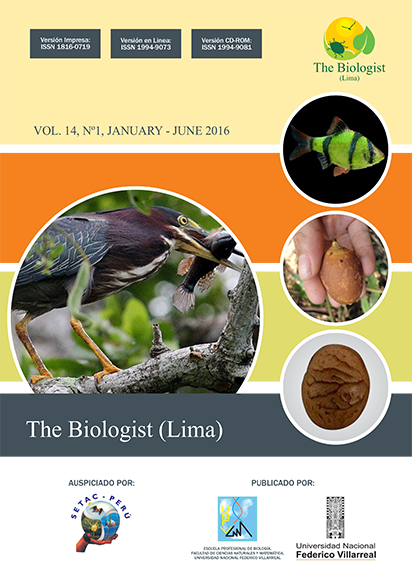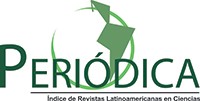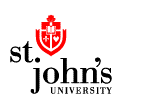OBTENCIÓN DE ESPORAS Y BIOMASA DE BEAUVERIA BASSIANA EN MEDIOS LÍQUIDOS SUPLEMENTADOS CON EURYSACCA MELANOCAMPTA Y PERONOSPORA FARINOSA
DOI:
https://doi.org/10.24039/rtb201614188Palabras clave:
Beauveria bassiana, Eurysacca melanocampta, quitina coloidal, laminarinaResumen
El objetivo de esta investigación fue estudiar el crecimiento de Beauveria bassiana, cultivado en medios líquidos suplementados con medio mínimo más sustratos artificiales (glucosa, laminarina o quitina coloidal) y con medio mínimo más sustratos naturales provenientes de Eurysacca melanocampta o Peronospora farinosa, para lo cual se evaluó el número de esporas y la cantidad de biomasa. Para ello se utilizó la cepa de B. bassiana CCB-LE 262, la cual fue inoculada en diferentes medios líquidos y donde se evaluó su crecimiento durante las 24 h, 96 h y 216 h. Nuestros resultados indican que a las 216 h la mayor cantidad de esporas se obtuvo en el medio artificial suplementado con laminarina (ML), con 67,80 esporas x 106·mL-1, mientras que el mejor medio natural fue el suplementado con polvo de E. melanocampta (M ) con 18,53 Em esporas x 106mL-1. La mejor biomasa se encontró a las 96 h, en el medio artificial de quitina coloidal (MQ) con 5.085 mg·mL-1 y a las 216 h para el medio natural M , fue de 8,59 mg·mL-1. Se Em concluye que el cultivo in vitro de B. bassiana, suplementados con sustratos de laminarina, quitina coloidal y E. melanocampta inducen la formación de esporas y de biomasa.
Descargas
Citas
Aroni, J.C.; Cayoja, M. & Laime, M. A. 2009. Situación actual al 2008 de la Quinua Real en el altiplano sur de Bolivia. Oruro-Potosi. Primera edición. Versión libre online.
Campos, R.A.; Arruda, W.; Boldo, J.T.; Silva, M.V.; Barros, N.M.; Azevedo, J.L.; Schrank, A. & Vainstein, M.H. 2005.
Boophilus microplus infection by Beauveria amorpha and Beauveria bassiana: SEM analysis and regulation of subtilisin-like proteases and chitinases. Current Microbiology, 50: 257-261.
Costa, J.; Jábar, E. & Gianol, E. 2009. Parasitismo sobre Eurysacca melanocampta Meyrick (Lepidoptera: Gelechiidae) en dos Localidades de Cusco, Perú. Revista Facultad Nacional de Agronomía, Medellín, 62: 4807- 4813.
Chou, T.Y.C.; Chang, M.M. & Tsao, G.T. 1981. Structure pre-treatment and hydrolysis of cellulose. Advances in Biochemical Engineering, 20:16-42.
Danielsen, S. & Ames, T. 2010. El mildiu de la quinua en la zona andina. Manual práctico para el estudio de la enfermedad y el patógeno. CIP. Manual versión libre online. http://cipotato.org/wp-content/uploads/2014/10/AN60198.pdf.
Dhar, P. & Kaur, G. 2010. Effects of carbon and nitrogen sources on the induction and repression of chitinase enzyme from Beauveria bassiana isolates. African Journal of Biotechnology, 9:8092-8099.
El-Katatny, M.H.; Gudelj, M.; Robra, K.H.; Elnaghy, M.A. & Gübitz, G.M. 2001. Characterization of a chitinase and anendo-β-1,3-glucanase from T. harzianum Rifai T-24 involved in control of the phytopathogen Sclerotium rolfsii. Applied Microbiology and Biotechnology, 56: 137-143.
Fan L.T., Lee Y.H. & Gharpuray M.M. 1982. The nature of lignocellulosics and their pretreatments for enzymatic hydrolysis. Advances in Biochemical Engineering, 23:158-187.
Fang, W.; Leng, B.; Xiao, Y.; Jin, K.; Ma, J.; Fan, Y.; Feng, J.; Yang, X.; Zhang, Y. & Pei, Y. 2005. Cloning of Beauveria bassiana chitinase gene Bbchit1 and its application to improve fungal strain virulence. Applied and Environmental Microbiology, 71: 363-370.
Fernandes, E. G.; Valério, H. M.; Feltrin, T.; & Van Der Sand, S. T. 2012. Variability in the production of extracellular enzymes by entomopathogenic fungi grown on different substrates. Brazilian Journal of Microbiology, 43: 827-833.
Gerding-González, M.; France, A.; Sepulveda, M.E. & Campos, J. 2007: Use of chitin to improve a Beauveria bassiana alginatepellet formulation. Biocontrol Science and Technology, 17:105-110.
Gessner, M. O. 1997. Fungal biomass, production and sporulation associated with particulate organic matter in streams. Limnetica, 13:33-44.
Hahn-Hägerdal, B. & Palmqvist, E. 2000. Fermentation of lignocellulosic hydrolysates. II: Inhibitors and mechanisms of inhibition. Bioresource Technology, 74: 25 -33.
Hernández, N.C.M.; Varo, A.W.E.; Leyva, R.N.; Ramirez, B.N.A. & Andrade, O.J. 2008. Utilización de residuos de cáscara de camarón para la obtención de quitina blanqueada: propuesta de una metodología en base de tratamientos alcalino-base y ozono. Avances de la Investigación Científica en CUBCA, Universidad de Guadalajara. pp. 659- 666.
Hsieh, C.; Tseng, M.H. & Liu, C.J. 2006. Production of polysaccharides from Ganoderma lucidum (CCRC 36041): under limitations of nutrients. Enzyme and Microbial Technology, 38: 109-117.
Husnain, H.; Ali, A.S.; Irfan, M.U.H.; Ali, A. & Muhammed, U. 2014. Efficacy of Entomopathogenic Fungi as Biological Control agent against insect pests of Gossypium hirsutum. Journal of Natural Sciences Research,4: 68-72.
Jenkins, N.E. & Prior, C. 1993. Growth and formation of true conidia by Metarhizium flavoviride in a simple liquid medium. Mycologycal Research, 97: 1489-1494.
Khan, N.; Tyagi, P. J. & Mishra, M. 2013. Isolation of Brauveria Bassiaana from white Grubs and Comparing their growth on natural and artificial medium. International Journal of Biotechnology and Bioengineering Research, 4: 415- 420.
Kim, S.; Hwang, H.; Xu, C.; Na, Y.; Song, S. & Yun, J. 2002. Influence of nutritional conditions on the mycelial growth and exopolysac-charide production in Paecilomyces sinclairii. Letters in Applied Microbiology, 34: 389-393.
Kubiceck, C.P.; Mach, R.L.; Peterbauer, C.K. & Lorito, M. 2001. Trichoderma: from genes to biocontrol. Journal of Plant Pathology, 83:11-23. Lee, J. 1997. Biological conversion of lignocellulosic biomass to ethanol. Journal of Biotechnology, 56: 1- 24.
Lee, W. Y.; Park, Y.; Ahn, J.K.; Ka, K.H. & Park, S. Y. 2007. Factors influencing the production of endopolysaccharide and exopo-lysaccharides from Ganoderma applanatum. Enzyme and Microbial Technology, 40: 249-254.
Lin, E. & Chen, Y. 2007. Factors affecting my celial biomass and exopolysaccharide production in submerged cultivation of Antrodia cinnamomea using complex media. Bioresource Technology, 98: 2511- 2517.
Ljungdahl L.G. & Eriksson K.E. 1985. Ecology of microbial cellulose degration. Advances in Microbial Ecology, 8:237-299.
Lohse, R.; Jakobs-Schönwandt, D. & Patel, A. V. 2014. Screening of liquid media and fermentation of an endophytic Beauveria bassiana strain in a bioreactor. AMB Express, a Springer Open Journal, 4:47.
Manjula, K.; Kishore, G. & Podile, A. 2004. Whole cells of Bacillus subtilis AF 1 proved more effective than cell free and chitinase-based formulations in biological control of citrus fruit rot and groundnut rust. Canadian Journal of Microbiology, 50:737744.
Mishra, S.; Kumar, P. & Malik, A. 2013. Effect of process parameters on the enzyme activity of a novel. International Journal of Current Microbiology and Applied Sciences, 2: 49-56.
Merzendorfer, H. & Zimoch, L. 2003. Review Chitin metabolism in insects: structure, function and regulation of chitin synthases and chitinases. The Journal of Experimental Biology, 206: 4393-4412.
Mohanty, S.S & Prakash, S. 2004. Extracellular metabolites of Trichophyton ajelloi against Anopheles stephensi and Culex quinquefasciatus larvae. Current Science, 86: 323-325.
Mustafa, U. & Kaur, G. 2009. Effects of carbon and nitrogen sources and ratio on the germination, growth and sporulation characteristics of Metarhizium anisopliae and Beauveria bassiana isolates. African Journal of Agricultural Research, 3: 922-930.
Nahayo, A. & Bayisenge, J. 2012. Biological control of coffee antestia bugs (Antestiopsis lineaticolis) by using Beauveria bassiana. New York Science Journal, 5: 106-113.
Ordentlich, A.; Elad, Y. & Chet, I. 1988. The role of chitinase of Serratia marcescensin biocontrol of Sclerotium rolfsii. Phytopathology, 78:84-88.
Pedrini, N.; Crespo, R. & Juárez, M.P. 2007. Biochemistry of insect epicuticle degradation by entomopathogenic fungi. Comparative Biochemistry and Physiology, Part C, 146:124-137.
Pereira, J.L.; Noronha, E.F.; Miller, R.N.G. & Franco, O.L. 2007. Novel insights in the use of hydrolytic enzymes secreted by fungi with biotechnological potential. Letters in Applied Microbiology, 44: 573–581.
Pham, T. A.; Kim, J. J.; Kim, S. G. & Kim, K. 2009. Production of blastospore of entomopathogenic Beauveria bassiana in a submerged batch culture. Mycobiology, 37: 218-224.
Prasad, C.S. & Pal, R. 2014. Mass Production and Economics of Entomopathogenic Fungus, Beauveria bassiana , Metarhizium anisopliae and Verticillium lecanii on agricultural and industrial waste. Scholars Journal of Agriculture and Veterinary Sciences, 1:28-32.
Romano, 2013. Producción y extracción de esporas del hongo entomopatógeno Beauveria bassiana (Balsamo) Vuillemin por fermentación en medio s ó l i d o . Te s i s d e M a e s t r í a e n Biotecnología. Universidad autónoma metropolitana – México.
Sahab A.F. & Sabbour M.M. 2011. Virulence of four entomopathogenic fungi on some cotton pests with especial reference to impact of some pesticides, nutritional and environmental factors on fungal growth. Egyptian journal of biological pest control, 21: 61-67.
Santa, H.S.D.; Santa, O.R.D.; Brand, D.; Vandenberghe, L.P.S. & Soccol, C.R. 2005. Spore production of Beauveria bassiana from agro-industrial residues, Brazilian Archives of Biology and Technology, 48: 51-60.
Senthamizhlselvan, P.; Sujeetha, J. A.R.P. & Jeyalakshmi, C. 2010. Growth, sporulation and biomass production of native entomopathogenic fungal isolates on a suitable medium. Journal of Biopesticides, 3: 466 - 469. Sinia, A. 2013. Evaluation of the Fungi Beauveria bassiana, Metarhizium anisopliae, and Clonostachys rosea as Bio-control Agents against the Honey Bee Parasitic Mite, Varroa destructor. Tesis de doctorado. The University of Guelph – Canada.
Smith R.J. & Grula, E.A. 1981. Nutritional requirements for conidial germination and hyphal growth of Beauveria bassiana. Journal of Invertebrate Pathology 3: 222-230.
St. Leger, R.J.; Cooper, R.M.; Charnley, A.K. 1986. Cuticle degrading enzymes of entomopathogenic fungi: regulation of production of chitinolytic enzymes. Journal of General Microbiology, 132: 1509-1517.
Struszczyk, M.H. & Struszczyk, K.J., 2007. Medical applications of chitin and its derivatives. Polish Chitin Society, Monograph XII.
Subramanian, C. & Punamalai, G. 2013. Optimization process for blastospore production of Beauveria bassiana isolates in poly ethylene glycol (peg) supplemented medium. International Journal of Current Microbiology and Applied Sciences, 2: 114-122.
Ting, A.S.Y. & Chai, J.Y. 2014. Chitinase and β - 1, 3 - glucanase activities of Trichoderma harzianumin response towards pathogenic and non-pathogenic isolates.
Thomas, K.C.; Khachatourians, G.G. & Ingledew, W.M. 1987. Production and properties of Beauveria bassiana conidia cultivated in submerged culture. Canadian Journal of Microbiology, 33:12-20.
Torres L.A.M., Quintero D.J.C & Atehortua G.L. 2011. Efecto de nutrientes sobre la producción de biomasa del hongo medicinal Ganoderma lucidum. Revista Colombiana de Biotecnología, 13:103- 109.
Vega, F.E.; Jackson, M. A.; Mercadier, G. & Poprawski, T.J. 2003. The impact of nutrition on spore yields for various fungal entomopathogens in liquid culture. World Journal of Microbiology & Biotechnology, 19: 363-368.
Viterbo, A.; Ramot, O.; Chernin, L. & Chet, I. 2002. Significance of lytic enzymes from Trichoderma spp. in the biocontrol of funal plant payhogens. Anton van Leeuwenhoek, 81: 549-556.
Wallander, H.; Nilsson, L. O.; Hagerberg, D. & Rosengren, U. 2003. Direct estimates of C:N ratios of ectomycorrhizal mycelia collected from Norway spruce forst soils . Soil Biology & Biochemistry, 35: 997-999.
Wu, J.; Cheung, P.; Wong, K. & Huang, N. 2004 . Studies on submerged fermentation of Pleurotus tuber-regium (Fr.) Singer. Part 2: effect of carbon-tonitrogen ratio of the culture medium on the content and composition of the mycelial dietary fibre. Food Chemistry, 85: 101-105.
Publicado
Cómo citar
Número
Sección
Licencia
Derechos de autor 2016 The Biologist

Esta obra está bajo una licencia internacional Creative Commons Atribución-NoComercial-SinDerivadas 4.0.
Objeto: El AUTOR-CEDENTE transfiere de manera TOTAL Y SIN LIMITACIÓN alguna al CESIONARIO (Revista The Biologist (Lima)) los derechos patrimoniales que le corresponden sobre sus obras por el tiempo que establezca la ley internacional. En virtud de lo anterior, se entiende que el CESIONARIO adquiere el derecho de reproducción en todas sus modalidades, incluso para inclusión audiovisual; el derecho de transformación o adaptación, comunicación pública, traducción, distribución y, en general, cualquier tipo de explotación que de las obras se pueda realizar por cualquier medio conocido o por conocer en el territorio nacional o internacional.
Remuneración: La cesión de los derechos patrimoniales de autor que mediante este contrato se hace será a título gratuito.
Condiciones y legitimidad de los derechos: El AUTOR-CEDENTE garantiza que es propietario integral de los derechos de explotación de la(s) obra(s) y en consecuencia garantiza que puede contratar y transferir los derechos aquí cedidos sin ningún tipo de limitación por no tener ningún tipo de gravamen, limitación o disposición. En todo caso, responderá por cualquier reclamo que en materia de derecho de autor se pueda presentar, exonerando de cualquier responsabilidad al CESIONARIO.
Licencia de acceso abierto: El AUTOR-CEDENTE autoriza que manuscrito publicado en la Revista Científica The Biologist (Lima) (versión Impresa ISSN 1816-0719, versión en línea ISSN 1994-9073) permanece disponible para su consulta pública en el sitio web http://revistas.unfv.edu.pe/index.php/rtb/index y en los diferentes sistemas de indexación y bases de datos en las que la revista tiene visibilidad, bajo la licencia Creative Commons, en la modalidad Reconocimiento-No comercial- Sin Trabajos derivados –aprobada en Perú, y por lo tanto son de acceso abierto. De ahí que los autores dan, sin derecho a retribución económica, a la Escuela Profesional de Biología, Facultad de Ciencias Naturales y Matemática de la Universidad Nacional Federico Villarreal (EPB - FCCNM - UNFV), los derechos de autor para la edición y reproducción a través de diferentes medios de difusión.








































